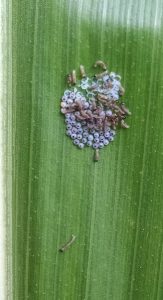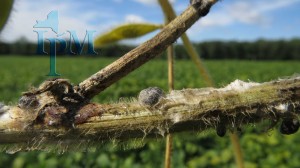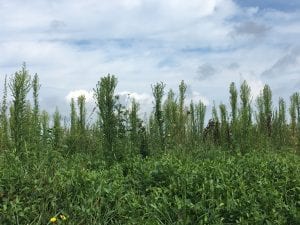Contents
View from the Field
Western Bean Cutworm Alert
We caught a record high of 14,327 moths in 64 traps, with an average of 224 moths/trap across the state last week. This week we caught 10,000 moths in 60 traps and in total for the year we are at 30,000 moths. This is more than last year’s total. Northern and Western NY are having the highest numbers with some traps over a 1000 in a week. Eastern NY trap numbers are steadily increasing from year to year. This is the 1st year we had fields over threshold in the upper Hudson Valley. Western Bean Cutworm (WBC) has been moving east from the Great Plains states across the U.S. In 2009, it made landfall in New York. It attacks corn by feeding on kernels grain yield as high as 40% loss. We currently have a WBC pheromone-trapping network statewide that is a combination of Cornell Cooperative Extension field crop specialist, educators, growers and crop consultants. They monitor the flight of the pest each summer helping to measure the increase and distribution across the state. This last week we caught many moths triggering growers and crop consultants to start scouting corn. The moths generally lay eggs in fields that are about to tassel. These fields should be focused for scouting. See table below for moth capture numbers by town/county.
For more scouting information please, refer to the following article: https://blogs.cornell.edu/ipmwpr/2112-2/
Downy Mildew on Soybeans
Jaime Cummings, NYS IPM
The weather has changed from hot and dry to warm and wet in many parts of the state, and that has changed our expectations for soybean diseases this year. Many of us are seeing downy mildew in soybeans across the state, ranging from low to high incidence and severity, and some are wondering what, if any, management options are recommended. As a general rule, we have never recommended spraying fungicides for downy mildew because this disease is typically more of a cosmetic issue which doesn’t tend to result in noticeable yield loss. Though, there have been reports from other states indicating 10-15% yield losses from very severe downy mildew epidemics. We have no established thresholds for when to pull the trigger for downy mildew fungicide management in New York State, and have no fungicide efficacy data to provide strong recommendations. And, keep in mind, most of our foliar fungicides available for soybeans are not labeled for downy mildew and would have very limited effect, if any, because downy mildew is an oomycete and is not in the same category as most of the rest of our foliar fungal diseases that are well controlled with many fungicides. There is limited research-based evidence that strobilurin fungicides may have limited efficacy against downy mildew, but, again, many aren’t actually labeled for downy mildew in NY. However, Aproach Prima is labeled for downy mildew in soybeans in NY, and can be applied at a 5 – 6.8 fl oz/A rate (http://www.cdms.net/ldat/ldBA3003.pdf). Given the general lack of efficacy data from NY or other states, it is unclear whether or not these applications will be cost effective, and should be reserved only for the most severely affected fields.
Soybean Aphids
Soybean aphids (Glycine max) populations are still rising. There have been some reports of them over the 250 aphids/plant economic threshold between the R1 and R5 stage of soybean growth. There are also many natural enemies like lady beetles, lacewing larvae (aka antlions), big eye bugs, predatory stinkbugs and more. If a field reaches threshold go back and check the field 2 to 3 days later, and determine if the population is increasing, decreasing or staying about the same. If the field increases with the number of aphids, a spray would be likely if the variety is not resistant. Many times the natural enemies can hold a population under the threshold. Here is an article on how to scout for soybean aphids: https://blogs.cornell.edu/ipmwpr/scouting-soybean-aphid/
White Mold in Soybeans
There are reports of field mold in soybean fields in Livingston County. White mold is a very problematic disease of soybeans that can limit yields.
Marestail (Horseweed)
Bryan Brown (NYS IPM) states that horseweed is starting to go to seed in unplanted areas. These populations of horseweed may have resistance to glyphosate. These fields should be mowed immediately to reduce production of their wind-blown seed. Tillage or contact herbicide applications after mowing will further limit fall seed production.
Weather Outlook – August 8, 2018
Jessica Spaccio
NOAA Northeast Regional Climate Center, Cornell University
Last week temperatures were 4-8 degrees above-normal. Precipitation has ranged from less than ½ “ to over 4”, with an additional tenth to 2” over the last 24 hours. Base 50 growing degree-days ranged from 130-190. Moderate drought continues in part of western and northern NY; conditions improved in Otsego & Schoharie.
Seasonable temperatures, only scattered showers and thunderstorms till next week when heavy rain is possible.
Today temperatures will be in the upper 70s and 80s with mostly dry conditions after morning showers move out, humid conditions will linger. Overnight lows will be in the upper 50s to upper 60s with a cold front bringing a chance of showers and thunderstorms.
Friday highs will be in the mid 70s to mid 80s with scattered showers and thunderstorms and lower humidity. Overnight temperatures will be in the mid 50s to near 60.
Saturday temperatures will be in the mid 70s to low 80s, it will be a mostly dry day with some scattered showers and thunderstorms. Overnight temperatures will be in the mid 50s to low 60s.
Sunday highs will be in the mid 70s to mid 80s with mostly dry conditions, an isolated afternoon shower or thunderstorm is possible. Overnight temperatures will be in the low to mid 60s.
Monday temperatures will be in the mid 70s to mid 80s with widespread showers and thunderstorms in the afternoon. Overnight temperatures will be in the 60s.
Tuesday highs will be in the mid 70s to low 80s with showers and thunderstorms likely, with heavy rainfall possible. Overnight temperatures will be in the 60s.
Wednesday highs will be in the 80s with high humidity and lingering showers. Overnight temperatures will be in the 60s.
The seven-day precipitation amounts will range from half an inch to one inch for most of the state, up to 2” in southeast NY. Locally heavy rainfall next week will increase these amounts for some areas.
The 8-14 day outlook (Aug 16-27) favors above-normal temperatures for all of the state and favors above-normal precipitation for most of the state, excluding part of southeast NY.
National Weather Service watch/warnings map:
CLIMOD2 (NRCC data interface):
Western Bean Cutworm Report
Clipboard Checklist
Keith Waldron, NYS IPM
General
*Walk fields to check general field condition, weed, vertebrate and other issues
*Watch for crop maturity, stand assessments, weed escapes, nutrient deficiencies, lodging issues
Alfalfa:
*Evaluate established legume stands for approximate days until harvest
*Monitor potato leafhopper, foliar, systemic and crown rot diseases.
*Monitor new seedings for potato leafhopper, pythium blight, phytopthora root rot.
Small Grains:
*Monitor grain fields for growth stage, disease and lodging issues, grain maturity, harvest timing
*Record diseases present, location and types of weed escapes
Corn:
*Monitor for mid-season corn pests including European corn borer, corn rootworm, western bean cutworm, slugs, foliar diseases such as northern corn leaf blight and gray leaf spot, weed issues, nutrient deficiencies, vertebrate damage.
Soybeans:
*Monitor for soybean aphid, defoliators, foliar diseases, white mold, weed issues, vertebrate damage
Pastures:
*Check water sources, mend fences as needed.
*Check crop growth, clip pastures between grazing as needed
*Monitor for invasive species, plants harmful to livestock
*Review/Plan rotations
Storage:
* Check stored grain bins for temperature, moisture and signs of mold and insects. Aerate, core, transfer grain or treat as necessary
* Clean and disinfect empty storage bins in preparation for grain harvest
*Check forage allocation and anticipate feed program adjustments as forages from previous year are used up
*Mow around storage bins and facility to minimize pest hiding places
Dairy Cattle Barn Fly Management:
*Monitor animals and barn area for house fly, stable fly and other pest management needs including presence of rodents and birds.
*Check facilities for favorable fly breeding conditions: (organic matter + moisture): leaks in watering systems, roof gutters for leaks and potential overspill, drainage,
*Sanitation, sanitation, sanitation – clean animal resting areas, feed troughs, minimize source of moist organic matter i.e. fly breeding areas in barn and in adjacent animal loafing yard
* Continue fly monitoring: install “3X5″ index card fly speck monitoring cards throughout barn
*Use, replenish, replace fly management materials: sticky fly tapes/ribbons, insecticide baits, natural enemies (parasitoids), fly population monitoring (3 x 5) spot cards
*Consider purchase and release of Muscidifurax raptor and/or M. raptorellus natural enemies of house and stable fly pupae.
Dairy Cattle on Pasture:
*Monitor animals for presence of face flies, horn flies and stable flies. Action guidelines: face flies (average 10 per animal face), horn flies (average 50 / dairy per animal side, 200 / beef cattle per animal side), stable flies average 10 per animal (all four legs)
*Check feed bunk / water source locations for signs of stable fly breeding (moist undisturbed organic matter – spilled feed, round bales, etc.), minimize source of moist organic matter i.e. fly breeding areas in barn and in adjacent animal exercise yard.
*Check pasture for forage quality / quantity, rotate as appropriate
*Check pasture for vegetation poisonous to livestock
*Consider use of pasture fly traps to help reduce deer, horse and stable fly populations







